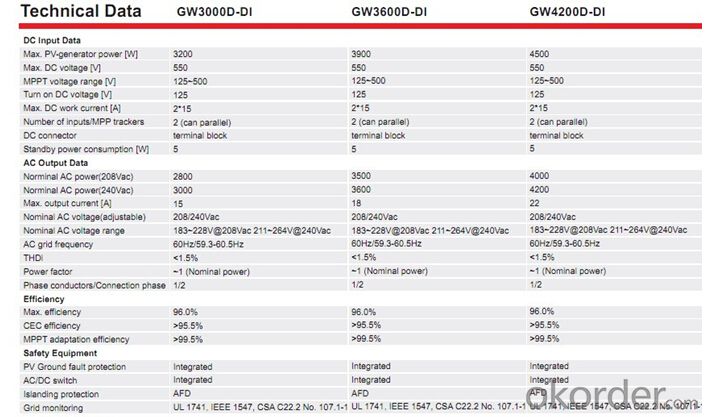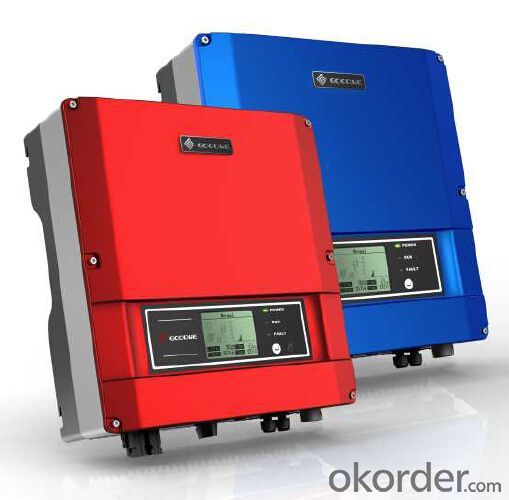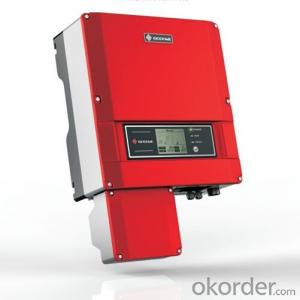On grid solar inverter GW3600D-DI (High Frequency Isolated)
- Loading Port:
- Shanghai
- Payment Terms:
- TT OR LC
- Min Order Qty:
- 12 pc
- Supply Capability:
- 1000 pc/month
OKorder Service Pledge
OKorder Financial Service
You Might Also Like
GW3000/3600/4200D-DI (High Frequency Isolated)
1.SPECIFATION
is the new on-grid PV inverter which integrated with most advanced technology, come with 10 years warranty,
and are designed to meet the new IEE1547 requirements for the North American market. Also it’s suitable for thick-film modules.
Easy installation and simple operation make them ideal for residential and small-to-medium commercial applications.
GoodWe inverters, with ever-increasing efficiency and high stability,
could ensure you better overall performance of solar power systems and shorter payback periods.
2.Datasheet

3. Solar inverter certification
EN 61000
VDE 0126-1-1
C10/11
G83/2
UTE C15-712-1
AS4777
CQC
CE10-21
EN50438
4.solar inverter picture

FAQ
1. What price for each watt?
It depends on the efficiency of the solar cell, quantity, and delivery date and payment terms.
2. How long can we receive the product after purchase?
In the purchase of product within three working days, We will arrange the factory delivery as soon as possible. The pacific time of receiving is related to the state and position of customers. Commonly 7 to 10 working days can be served.
We can provide you not only the solar material but also the off grid solar system, we can also provide you service with on grid plant.
4. How do you pack your products?
We have rich experience on how to pack the solar cell to make sure the safety on shipment; we could use wooden box or pallet as buyer's preference.
5. Can you do OEM for us?
Yes, we can.
- Q:Can a solar inverter be used in regions with high levels of lightning activity?
- Yes, a solar inverter can be used in regions with high levels of lightning activity. However, it is important to ensure that the solar inverter is properly installed and equipped with surge protection devices to mitigate the risks associated with lightning strikes. Additionally, regular maintenance and inspections should be carried out to ensure the safety and functionality of the solar inverter in such regions.
- Q:How does a solar inverter handle sudden changes in solar irradiance?
- A solar inverter handles sudden changes in solar irradiance by continuously monitoring the incoming solar energy and adjusting its output accordingly. When there is a sudden increase in solar irradiance, the inverter quickly ramps up its power output to match the new level of energy being generated. Similarly, if there is a sudden decrease in solar irradiance, the inverter rapidly decreases its output to prevent overloading. This dynamic response ensures optimal power generation and protects the system from potential damage due to irregular fluctuations in solar irradiance.
- Q:What is the role of a solar inverter in power factor correction?
- The role of a solar inverter in power factor correction is to convert the direct current (DC) generated by the solar panels into alternating current (AC) that can be used by the electrical grid. In doing so, the solar inverter ensures that the AC power being fed into the grid has a power factor close to unity, which means it is efficient and does not cause any unnecessary strain on the electrical system. This helps to improve the overall power quality and efficiency of the solar energy system.
- Q:How is the size of a solar inverter determined?
- The size of a solar inverter is determined based on the maximum power output of the solar panels connected to it. It should match or exceed the total capacity of the solar panels to ensure optimal performance and avoid any power limitations.
- Q:Can a solar inverter be connected to a generator?
- Yes, a solar inverter can be connected to a generator. This allows the solar energy system to work in conjunction with the generator, providing additional power when the solar energy is insufficient or unavailable. The generator serves as a backup power source, ensuring a continuous supply of electricity.
- Q:How does a solar inverter handle ground fault protection?
- A solar inverter handles ground fault protection by continuously monitoring the flow of current between the solar panel array and the ground. If it detects any abnormal current leakage or ground faults, it quickly shuts down the system to prevent any potential electrical hazards or damage.
- Q:Are solar inverters compatible with different solar panel technologies?
- Yes, solar inverters are generally compatible with different solar panel technologies. Most modern solar inverters are designed to work with a wide range of solar panel technologies, including monocrystalline, polycrystalline, and thin-film panels. However, it is always recommended to check the specifications and compatibility of the specific inverter with the desired solar panel technology before making a purchase.
- Q:Are solar inverters compatible with battery storage systems?
- Yes, solar inverters are compatible with battery storage systems. In fact, solar inverters play a crucial role in integrating battery storage with solar power systems. Solar inverters convert the direct current (DC) electricity generated by the solar panels into alternating current (AC) electricity that can be used to power our homes and businesses. Battery storage systems, on the other hand, store excess solar energy for later use, allowing us to use solar power even when the sun is not shining. When combined with solar inverters, battery storage systems can be charged using the excess energy generated by the solar panels during the day, and then discharge that stored energy during the night or during periods of high energy demand. To facilitate compatibility, solar inverters used in battery storage systems are equipped with additional features and functionalities. For example, they may have built-in charge controllers that regulate the charging and discharging of the batteries, ensuring their optimal performance and longevity. Additionally, advanced inverters may also include smart grid capabilities, allowing them to communicate with the utility grid and optimize energy flows based on grid conditions and electricity prices. Overall, solar inverters are essential components in ensuring the seamless integration of battery storage systems with solar power, enabling us to maximize the benefits of clean and sustainable energy.
- Q:What is the role of frequency support in a solar inverter?
- The role of frequency support in a solar inverter is to ensure that the electricity generated by the solar panels is synchronized with the frequency of the electrical grid. This support is necessary to maintain grid stability and prevent any disruptions caused by fluctuations in frequency. The solar inverter monitors the grid frequency and adjusts the output of the solar panels accordingly, either by increasing or decreasing the power generation, to match the grid's frequency requirements.
- Q:What are the key differences between a central inverter and a string inverter?
- The key differences between a central inverter and a string inverter lie in their design and functionality. A central inverter is a single large inverter that is typically installed at a central location in the solar power system. It receives the DC power generated by multiple solar panels connected in series, and then converts it into AC power for use in the electrical grid. Central inverters are more suitable for large-scale solar installations as they can handle higher power outputs. On the other hand, a string inverter is a smaller inverter that is installed close to the solar panels. It works by converting the DC power generated by a string of panels, typically 8 to 12, into AC power. String inverters are commonly used in residential or smaller commercial solar installations. One notable difference is the location of the inverters. Central inverters are typically installed in a dedicated room or enclosure, away from the solar panels, whereas string inverters are generally mounted either on the wall or directly on solar panel mounting racks. Another difference is the impact of shading or panel malfunction. In a central inverter system, if one panel is shaded or malfunctions, it affects the output of the entire string of panels. In contrast, with a string inverter system, the impact is limited to only the affected string, allowing other strings to continue generating power efficiently. Additionally, string inverters offer better monitoring capabilities as they can provide real-time data for each individual string of panels, allowing for easier troubleshooting and maintenance. Central inverters, on the other hand, provide a single output value for the entire solar array. Overall, the choice between a central inverter and a string inverter depends on the scale of the solar installation, the available space, and the specific requirements of the project.
1. Manufacturer Overview |
|
|---|---|
| Location | |
| Year Established | |
| Annual Output Value | |
| Main Markets | |
| Company Certifications | |
2. Manufacturer Certificates |
|
|---|---|
| a) Certification Name | |
| Range | |
| Reference | |
| Validity Period | |
3. Manufacturer Capability |
|
|---|---|
| a)Trade Capacity | |
| Nearest Port | |
| Export Percentage | |
| No.of Employees in Trade Department | |
| Language Spoken: | |
| b)Factory Information | |
| Factory Size: | |
| No. of Production Lines | |
| Contract Manufacturing | |
| Product Price Range | |
Send your message to us
On grid solar inverter GW3600D-DI (High Frequency Isolated)
- Loading Port:
- Shanghai
- Payment Terms:
- TT OR LC
- Min Order Qty:
- 12 pc
- Supply Capability:
- 1000 pc/month
OKorder Service Pledge
OKorder Financial Service
Similar products
New products
Hot products
Hot Searches
Related keywords































